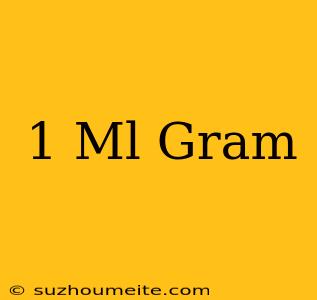1 ml = gram: Understanding the Conversion
Introduction
When working with liquids, it's essential to understand the relationship between volume and weight. One common question that arises is whether 1 milliliter (mL) is equal to 1 gram (g). In this article, we'll delve into the world of conversion and explore the answer to this question.
What is a Milliliter (mL)?
A milliliter is a unit of volume in the metric system, equivalent to one-thousandth of a liter. It's commonly used to measure the volume of liquids, such as water, oil, or chemicals.
What is a Gram (g)?
A gram is a unit of mass or weight in the metric system. It's equivalent to one-thousandth of a kilogram. Grams are used to measure the weight of objects, substances, or materials.
The Conversion: 1 mL = 1 g?
So, is 1 mL equal to 1 g? The answer is not always straightforward.
For water, 1 mL is approximately equal to 1 g. This is because the density of water is very close to 1 g/mL. This means that if you have 1 mL of water, it will weigh around 1 g.
For other liquids, the conversion is not so simple. The density of a liquid can vary greatly, depending on its composition and properties. For example, honey has a density of around 1.4 g/mL, while gasoline has a density of around 0.7 g/mL. This means that 1 mL of honey would weigh around 1.4 g, while 1 mL of gasoline would weigh around 0.7 g.
Conclusion
In conclusion, the conversion 1 mL = 1 g is only true for water and a few other substances with a density very close to 1 g/mL. For other liquids, the conversion depends on their specific density. It's essential to understand the properties of the liquid you're working with to make accurate conversions and calculations.
Remember: Always consider the density of the liquid when converting between volume and weight units.
